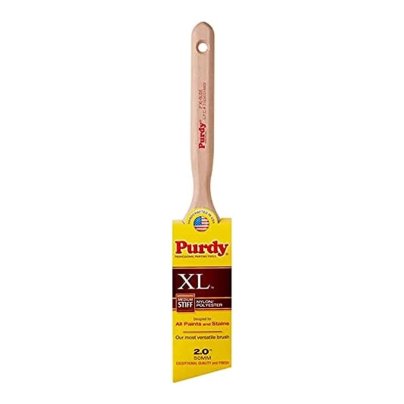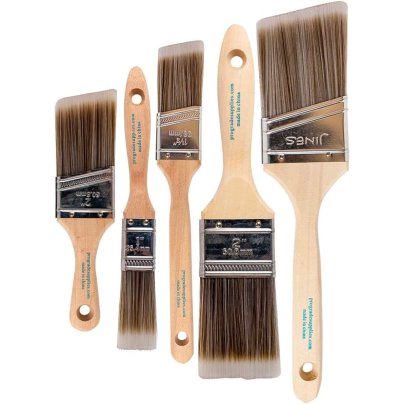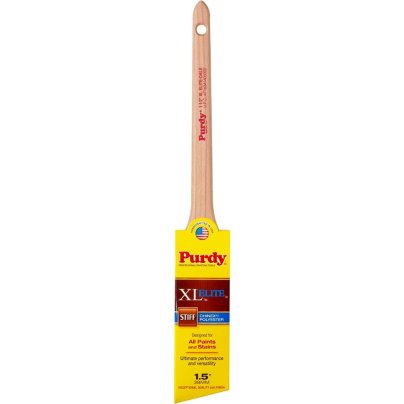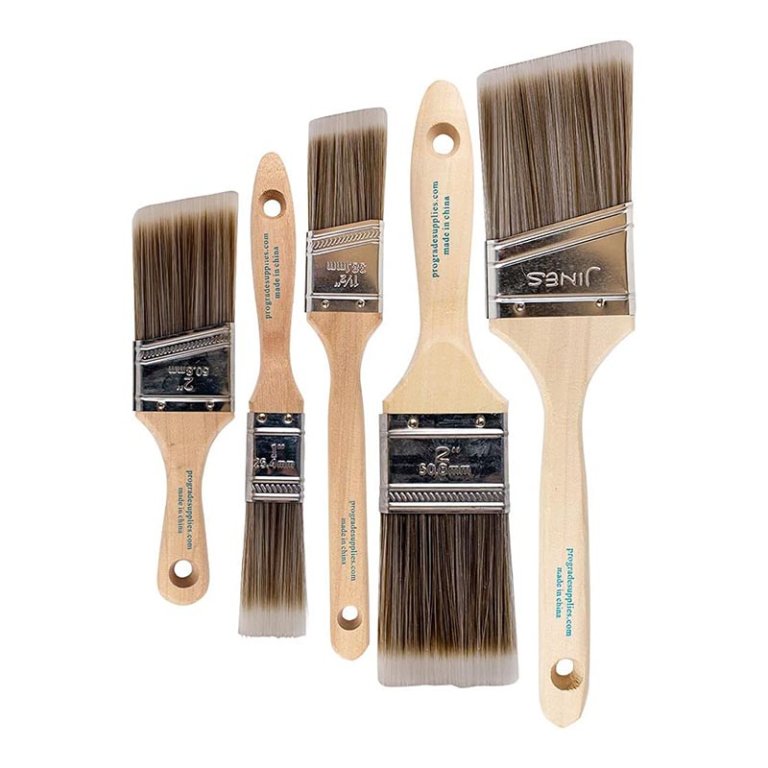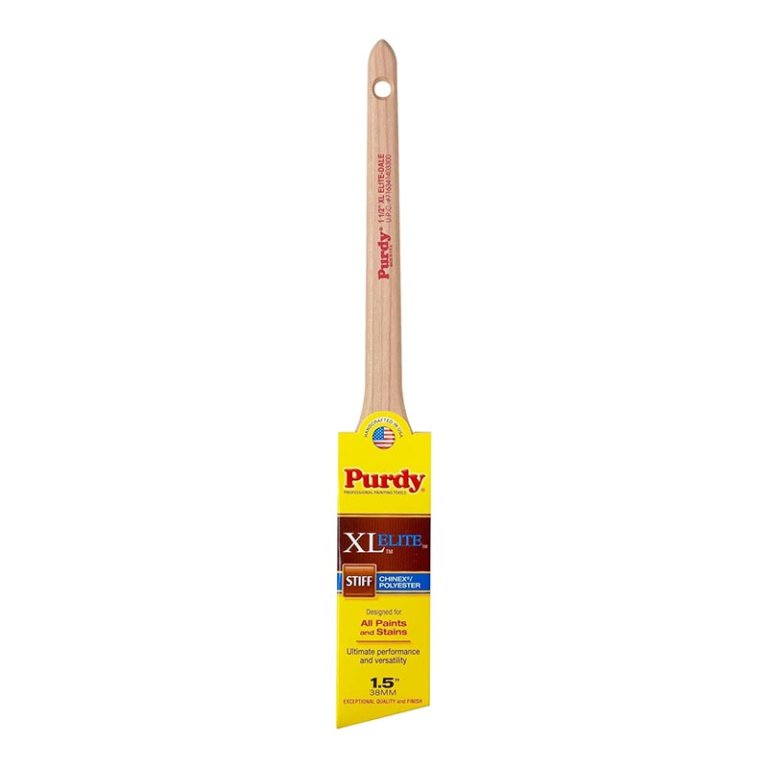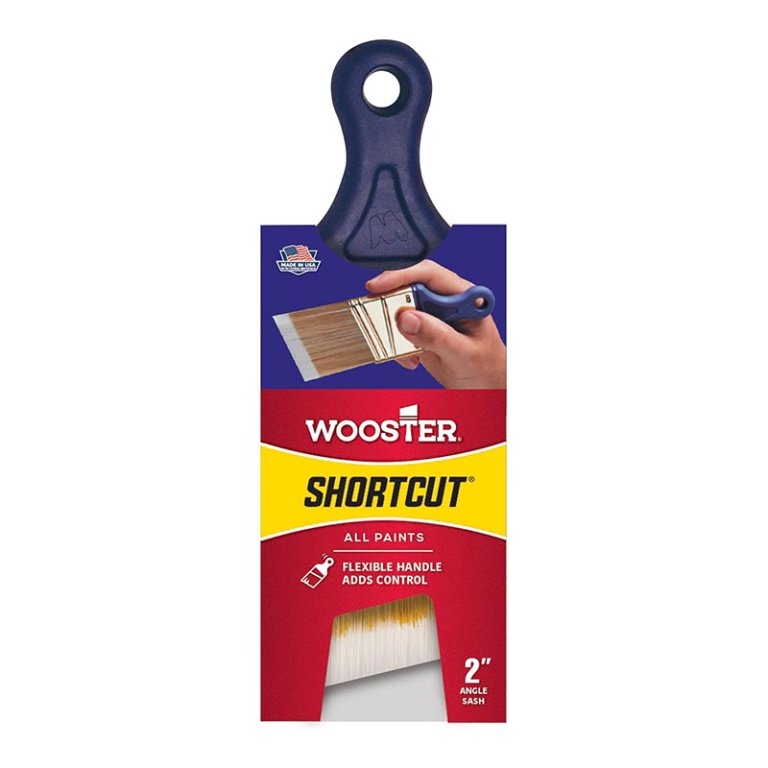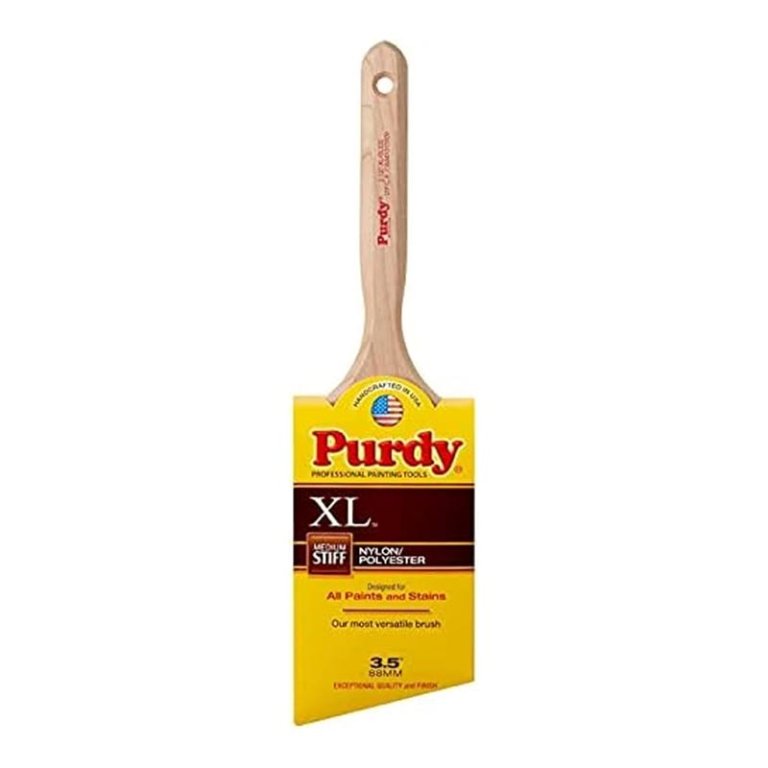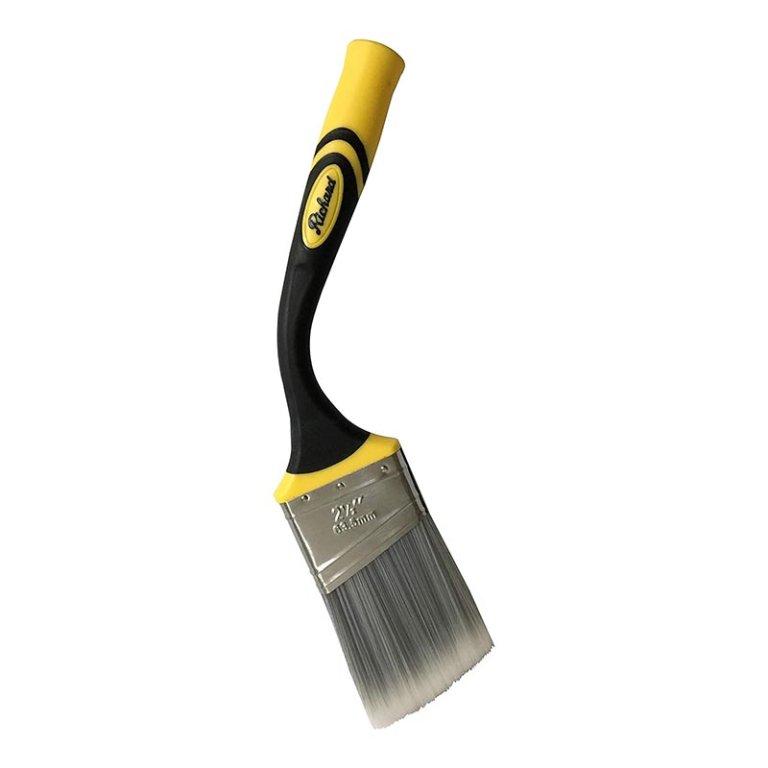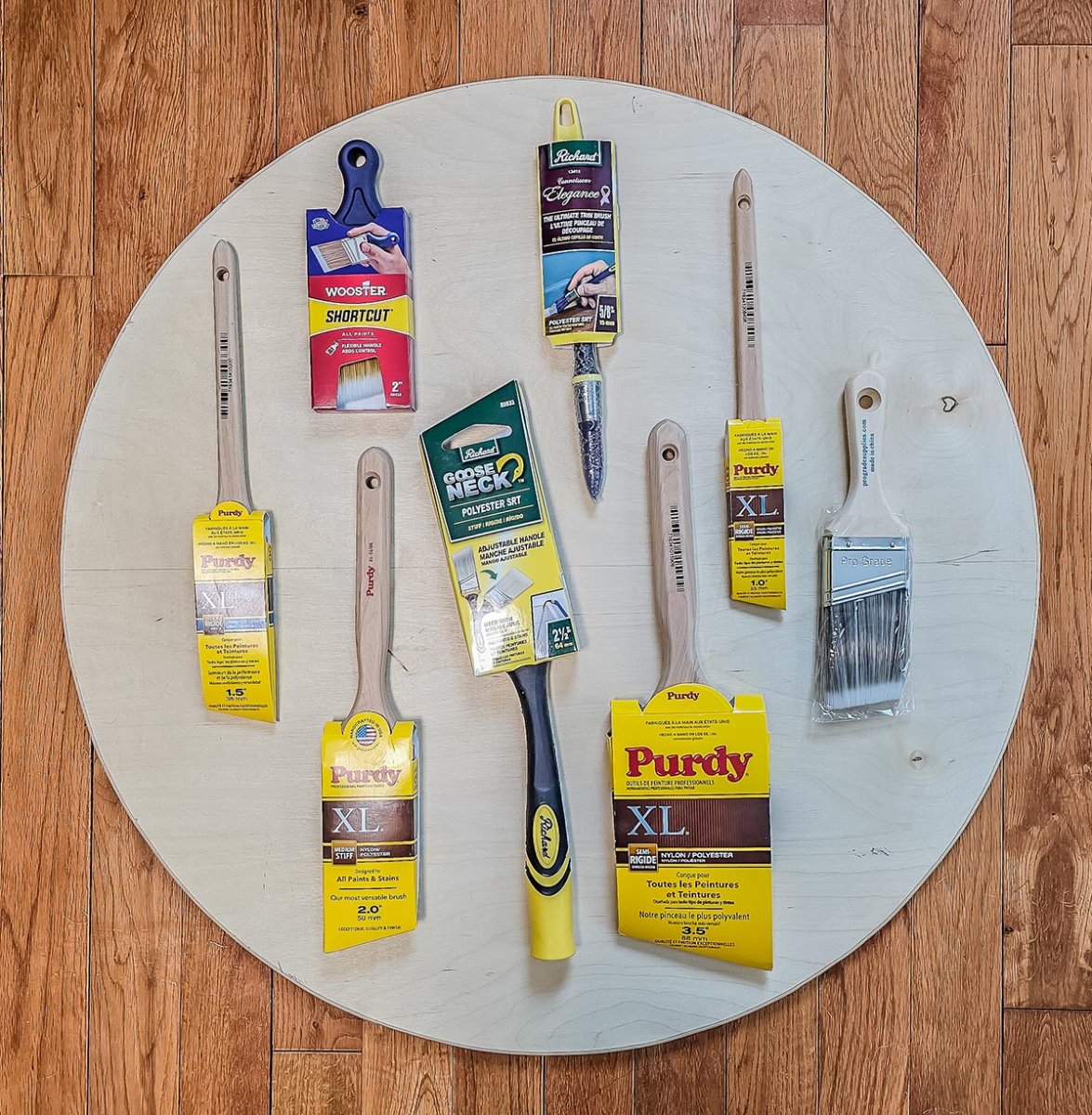
We may earn revenue from the products available on this page and participate in affiliate programs. Learn More ›
When precision painting is the name of the game, DIYers and pros alike will want to equip themselves with specialized paint brushes for trim to set themselves up for success. Regardless of skill level, the right paint brush can be the difference between a professional-looking paint job and an amateurish one. Trimwork is typically painted with gloss or semi-gloss enamel that catches the light and magnifies every brushstroke, so using a brush that won’t leave unsightly marks is your best bet—even if you aren’t an experienced painter.
We researched over 25 of today’s top paint brushes before selecting several for our hands-on testing. Our goal was to find high-quality trim paint brushes for dedicated DIYers, pros, and newbies. Our favorite was Purdy’s XL Glide 2-inch brush thanks to fine angled bristles and smooth wood handle. Keep reading to learn what to look for and find out how each pick on the following list earned its spot in our lineup of the best paint brushes for trim.
- BEST OVERALL: Purdy XL Glide 2-Inch Paint Brush
- BEST BANG FOR THE BUCK: Pro Grade 5-Piece Flat and Angle Paint Brush Set
- BEST FOR BASEBOARDS: Purdy XL Elite Dale 1.5-Inch Paint Brush
- BEST FOR NARROW TRIM: Purdy XL Dale 1-Inch Paint Brush
- BEST FOR TIGHT SPOTS: Wooster Brush Shortcut 2-Inch Angle Paint Brush
- BEST FOR WIDE TRIM: Purdy XL Glide 3.5-Inch Paint Brush
- BEST FOR CROWN TRIM: Richard Goose Neck 2.5-Inch Paint Brush
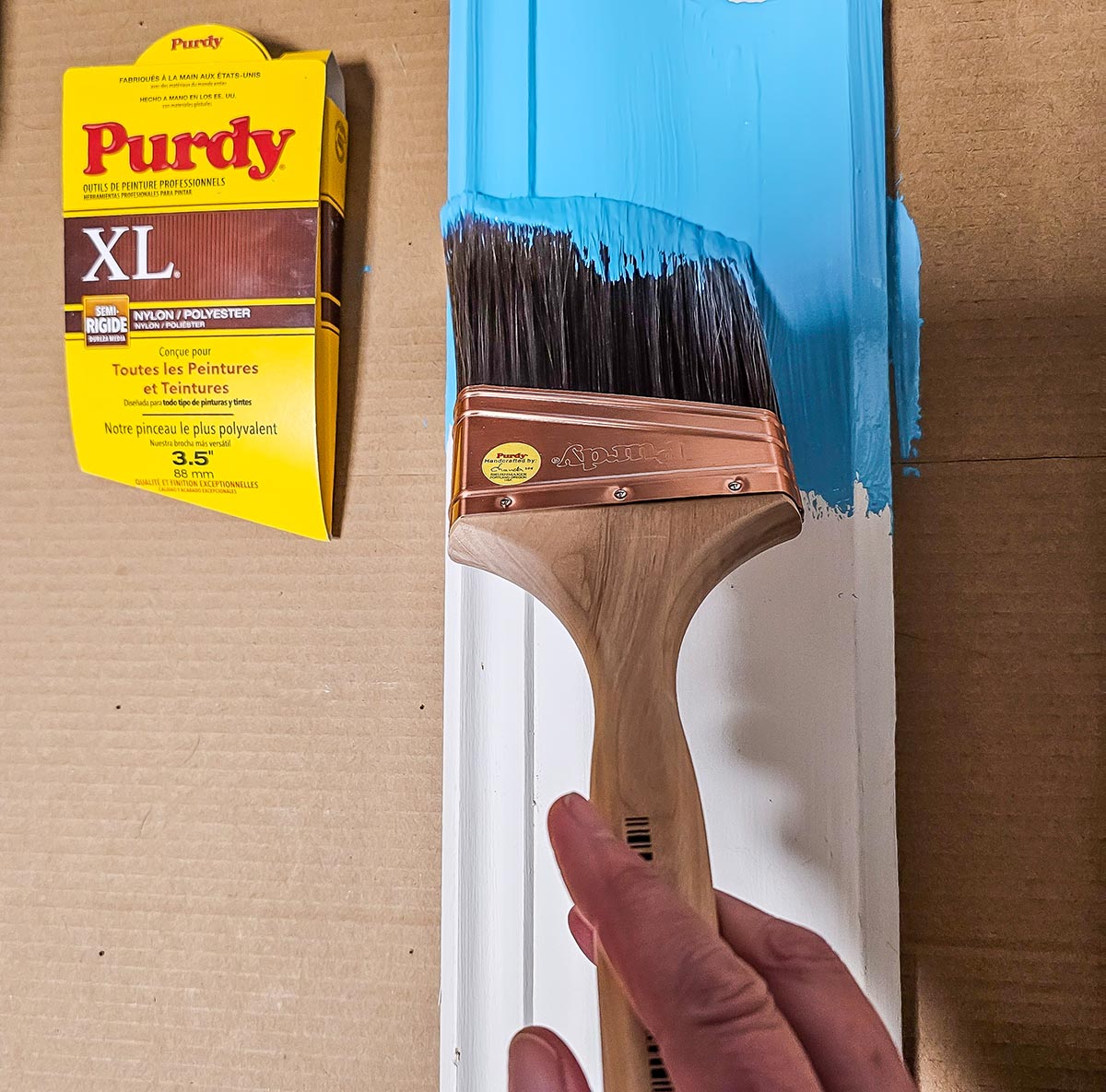
Paint Brushes for Trim Comparison
| Size | Shape | Bristle type | Compatibility | |
| Purdy XL Glide 2-Inch Paint Brush | 2 inches | Angled | Medium-stiff, nylon/polyester | All paints and stains |
| Pro Grade 5-Piece Flat and Angle Paint Brush Set | 1 to 2.5 inches | Angled and flat | Soft, synthetic | All paints and stains |
| Purdy XL Elite Dale 1.5-Inch Paint Brush | 1.5 inches | Angled | Stiff, Chinex and Orel (synthetic filaments) | All paints and stains |
| Purdy XL Dale 1-Inch Paint Brush | 1 inch | Angular | Medium-stiff, nylon/polyester | All paints and stains |
| Wooster Brush Shortcut 2-Inch Angle Paint Brush | 2 inches | Angled | Nylon and polyester | All paints |
| Purdy XL Glide 3.5-Inch Paint Brush | 3.5 inches | Angled | Medium-stiff, nylon/polyester | All paints and stains |
| Richard Goose Neck 2.5-Inch Paint Brush | 2.5 inches | Angled | Flagged, polyester | All paints |
Our Top Picks
Keep in mind that, second only to using a high-quality paint and finish brush, high-quality paint is vital to achieving professional results when painting trim. Each of the following paint brushes was tested on real trim—find out how they fared below.
Best Overall
Purdy XL Glide 2-Inch Paint Brush
See ItWhat We Like
- Fine bristles create smooth finish on wet paint
- 2-inch width fits standard trim boards
- Angled bristles help paint clean edges
- Wood handle resists slipping from moisture
- Cardboard cover protects bristles between uses
What We Don’t Like
- Too small for large-scale painting projects
Product Specs
- Size: 2 inches
- Shape: Angled
- Bristle type: Medium-stiff, nylon/polyester
- Compatibility: All paints and stains
Our Ratings: Overall 4.5/5; Ease of Use 4/5; Finish 4.5/5; Durability 5/5; Value 4.5/5
The Purdy XL Glide took top honors in our lineup with its ultrafine bristle tips that left our trim boards smooth and sleek. The 2-inch-wide brush is just the right size for painting most standard trim boards, and the angled bristles make it easy to create straight, crisp painted lines along the edges of the boards.
The Purdy XL Glide features a copper ferrule (the band that holds the bristles in place so they don’t flay), and the handle is made from smooth hardwood. A slight contour in the handle made it easy to hold and control the brush, and the wood absorbs light moisture to keep the handle from feeling slick should it get wet.
When the final coat of test paint dried, it was smooth—very few brush marks could be seen, even when we held the board under intense light. Part of that was due to our use of high-quality, self-smoothing paint, but without the Purdy brush, we could not have attained such a professional finish. We soaked the brush in water for a few hours before washing it out under a running faucet, and nearly all the residual paint came out.
A nice thing about Purdy is the cardboard covers they put on their brushes—they have hook-and-loop closures and can be reused for storage to keep the bristles in good shape.
Read our full review: Purdy XL Glide 2-Inch Paint Brush
Get the Purdy XL Glide 2-inch paint brush for trim at Amazon, Lowe’s, or Menards.
Best Bang for the Buck
Pro Grade 5-Piece Flat and Angle Paint Brush Set
See ItWhat We Like
- Five brushes for a budget-friendly price
- Multiple sizes offer flexibility for trim work
- Wood handles feel smooth and wick moisture
What We Don’t Like
- Bristle tips less refined—use quality paint
Product Specs
- Size: 1 to 2.5 inches
- Shape: Angled and flat
- Bristle type: Soft, synthetic
- Compatibility: All paints and stains
Our Ratings: Overall 4.5/5; Ease of Use 4.5/5; Finish 3.5/5; Durability 4/5; Value 5/5
For a fine array of brushes at a budget-friendly price, it’s hard to beat this set of paint brushes from Pro Grade. The set features five different size brushes, ranging in bristle width from 1 inch to 2.5 inches to suit a range of trim board sizes.
Despite the low price point, each Pro Grade trim paint brush performed well in our tests. While their bristle tips are less refined than some of the other brushes we tested, they gave us excellent finish results when used with high-quality, self-smoothing paint. We checked the finished trim boards under strong light when they dried and saw very few brush strokes. We were impressed overall, especially considering the set’s affordability.
A slight downside: We found an errant bristle that came off one of the Pro Grade brushes that we had to pick out of our wet paint. But there was only one. We felt that was still pretty good, as even a high-end brush can lose a bristle now and then.
The wood handles are fairly smooth, but we prefer them a bit smoother, so we ran a bit of 400-grit sandpaper over the handles before using them. The Pro Grade brushes cleaned up well. After soaking them, we washed them under a running faucet and removed virtually all traces of paint. When dry, we noticed a slight flaring of the bristles, which isn’t uncommon but suggests these brushes might not hold up perfectly to repeated use. Still, they are great little brushes for trim at an equally great price.
Get the Pro Grade paint brushes for trim at Amazon or Walmart.
Best for Baseboards
Purdy XL Elite Dale 1.5-Inch Paint Brush
See ItWhat We Like
- Stiff bristles give precision and clean lines
- Angled shape ideal for installed baseboards
- Works with all paints; leaves minimal marks
What We Don’t Like
- Stainless ferrule holds more paint than copper
Product Specs
- Size: 1.5 inches
- Shape: Angled
- Bristle type: Stiff, Chinex and Orel (synthetic filaments)
- Compatibility: All paints and stains
Our Ratings: Overall 4.5/5; Ease of Use 5/5; Finish 5/5; Durability 4/5; Value 4/5
Purdy has been a leader in the paint brush industry for decades, and its experience is evident in the second Purdy pick to make our list. The XL Elite Dale is a nice little trim brush that stands out due to the firmness of its bristles, which made it simple to apply paint uniformly to boards with deep grooves. In addition, the stiffness and angled bristles made it easier to create straight cut-in lines at the edges of our test boards.
The one thing we missed was the copper ferrule that comes standard on most Purdy paint brushes. The XL Elite Dale features a stainless steel ferrule that did an excellent job securing the bristles, but we found that dried bits of paint stuck to it and were harder to wash off than is typical of copper ferrules. However, that doesn’t affect the XL Elite’s ability to create a supersmooth finish—it’s very good at that. The bristles were easy to rinse clean of paint.
The synthetic Chinex and Orel bristles are very fine at the tips and left virtually no brushstrokes that we could see, even under strong light. This is a good pick for those who paint baseboards after they are installed—if you have a steady hand, this brush will help you paint the boards without slopping paint on the wall.
Get the Purdy XL Elite paint brush for trim at Amazon or Ace Hardware.
Best for Narrow Trim
Purdy XL Dale 1-Inch Paint Brush
See ItWhat We Like
- Great for narrow trim and detailed work
- Medium-stiff bristles give clean, sharp lines
- Fine tips feather paint to hide strokes
What We Don’t Like
- Thin wood handle could be more ergonomic
Product Specs
- Size: 1 inch
- Shape: Angular
- Bristle type: Medium-stiff, nylon/polyester
- Compatibility: All paints and stains
Our Ratings: Overall 4.5/5; Ease of Use 4/5; Finish 5/5; Durability 5/5; Value 4/5
Another XL pick from Purdy, this medium-stiff 1-inch paint brush is a standout for painting narrow trim strips. Like all the Purdy brushes we tested, this 1-inch version comes with a wood handle and very fine bristle tips, allowing us to achieve a near-perfect paint finish.
We were able to easily cut in along the board’s edges with the brush’s angled bristles, and the brush comes with a copper ferrule that seems to help keep dried bits of paint from sticking.
The only downside—and it’s just a personal preference—is that we found the wood handle a bit on the thin side. It’s still smooth to the touch and absorbs a bit of moisture to keep it from becoming slippery, but in our hands, it felt more like a carpenter’s pencil than a paint brush, and we would have preferred a bit more handle to hold on to.
After our paint tests, we soaked the brush in water for a couple of hours and then rinsed it under a faucet to remove residual paint. It dried nicely without the bristles flaying and was ready for the next trim painting project.
Get the Purdy XL Dale paint brush for trim at Amazon or Lowe’s.
Best for Tight Spots
Wooster Brush Shortcut 2-Inch Angle Paint Brush
See ItWhat We Like
- Handle fits comfortably and feels natural
- Highly controllable for clean and precise lines
- Durable, easy-to-maintain bristles
What We Don’t Like
- May leave visible strokes after second coat
Product Specs
- Size: 2 inches
- Shape: Angled
- Bristle type: Nylon and polyester
- Compatibility: All paints
Our Ratings: Overall 4.3/5; Ease of Use 4/5; Finish 4/5; Durability 5/5; Value 4/5
Sometimes, a long paint brush handle is too cumbersome to fit into narrow spots, such as between the side of a cabinet and a wall that sits just inches away. A short-handle brush like the Wooster Shortcut is just the ticket in those situations.
We’ve used Wooster Shortcut brushes in the past, primarily for cutting in along walls in restricted spots, but now we could see how well they performed the delicate task of trim painting.
The stubby handle on the Shortcut is flexible and bends easily to either side, but it’s still sturdy enough to control the bristles and paint placement. Painting trim typically takes a light touch rather than excess pressure, so the handle didn’t bend much in our tests. Still, it’s a nice feature.
The 2-inch Shortcut brush features angled nylon/polyester bristles that narrow to fine tips. While we got a decent finish on our test boards, it wasn’t quite as smooth as the finish left by the Purdy brushes. It was still acceptable because we tested with self-smoothing paint, but we could see a few brush marks under strong light after the second coat dried.
So, there’s a tradeoff with the Wooster Shortcut—while you can still get a good finish, you may want to limit its use to trim boards that are located in spots where a longer, finer brush just won’t fit. After all, the Wooster is still likely to give a better finish in those spots than a brush that’s too long to control while painting trim.
Get the Wooster paint brush for trim at Amazon, Ace Hardware, or The Home Depot.
Best for Wide Trim
Purdy XL Glide 3.5-Inch Paint Brush
See ItWhat We Like
- Wide base covers more area with fewer strokes
- Angled bristles make clean edge lines easy
- Copper ferrule and hardwood handle feel premium
What We Don’t Like
- Heavier bristle head may feel bulky to some
Product Specs
- Size: 3.5 inches
- Shape: Angled
- Bristle type: Medium-stiff, nylon/polyester
- Compatibility: All paints and stains
Our Ratings: Overall 4.5/5; Ease of Use 4/5; Finish 5/5; Durability 5/5; Value 4/5
Wide trim boards are more likely to show brush marks simply because there’s more surface area to catch the light, so even tiny discrepancies in the painted finish will show up. Unless you’re highly skilled at finish painting, using a narrow brush is probably a mistake because it can take three or more overlapping strokes to cover a wide trim board from side to side, increasing the risk of visible marks.
The 3.5-inch Purdy XL Glide brush solves that problem. It offers a wide bristle base that’s angled for cutting in along edges—we were able to paint wide trim boards with just a couple of strokes. Like all Purdy brushes, the 3.5-inch XL left a smooth finish that didn’t show brush strokes, even under strong light.
The handle is made from smooth hardwood, which absorbs a bit of moisture to keep it from getting slippery, and the brush has a nice copper ferrule, but we found it slightly bulky. For trim painting, the bristles’ thickness from front to back is more than we felt was necessary, and it added more bulk and weight than we really wanted. Still, it’s a great brush that can create a near-flawless finish when paired with high-quality paint.
Get the Purdy XL Glide 3.5-inch paint brush for trim at Amazon or Sherwin-Williams.
Best for Crown Trim
Richard Goose Neck 2.5-Inch Paint Brush
See ItWhat We Like
- Flexible handle reduces wrist strain overhead
- Extension pole compatible for hard-to-reach spots
- Applies paint smoothly with clean feathering
What We Don’t Like
- Extension pole can reduce trim precision
Product Specs
- Size: 2.5 inches
- Shape: Angled
- Bristle type: Flagged, polyester
- Compatibility: All paints
Our Ratings: Overall 4.3/5; Ease of Use 4/5; Finish 5/5; Durability 4/5; Value 4/5
Painting trim often means bending over or reaching overhead for hours on end, which can cause discomfort. The Richard 2.5-inch Goose Neck paint brush won’t prevent the need to reach overhead, but it comes with a flexible handle that can be bent at an angle to keep the painter from bending their wrist.
We’d never used a gooseneck brush before, and when the Richard brush arrived, it was perfectly straight—not bent at all. It takes some effort to bend the stiff brush handle, but once bent, it stays at that angle—it doesn’t gradually straighten back out. That’s a plus. Another perk with the Richard Goose Neck is the ability to attach a screw-in extension pole. However, getting a good finish on trim while using an extension pole can be challenging. It may be best to skip the pole, grab a sturdy ladder, and hold this brush by hand.
The Richard brush did a decent job of feathering out paint on our test boards, but we found two wayward bristles embedded in the paint. We think that was a fluke, however, because after washing the brush and letting it dry, we tugged firmly at the bristles, and no more came out.
The final results were good—after removing the errant bristles from the test boards and feathering out the paint, we found only faint brushstrokes on the finished boards.
Get the Richard paint brush for trim at Amazon.
Jump to Our Top Picks
How We Tested the Best Paint Brushes for Trim
| Overall | Ease of Use | Finish | Durability | Value | |
| Purdy XL Glide 2-Inch Paint Brush | 4.5 | 4 | 4.5 | 5 | 4.5 |
| Pro Grade 5-Piece Flat and Angle Paint Brush Set | 4.5 | 4.5 | 3.5 | 4 | 5 |
| Purdy XL Elite Dale 1.5-Inch Paint Brush | 4.5 | 5 | 5 | 4 | 4 |
| Purdy XL Dale 1-Inch Paint Brush | 4.5 | 4 | 5 | 5 | 4 |
| Wooster Brush Shortcut 2-Inch Angle Paint Brush | 4.3 | 4 | 4 | 5 | 4 |
| Purdy XL Glide 3.5-Inch Paint Brush | 4.5 | 4 | 5 | 5 | 4 |
| Richard Goose Neck 2.5-Inch Paint Brush | 4.3 | 4 | 5 | 4 | 4 |
We’ve been painting for years, and while we have our old standbys, we also recognize that as technology improves, paint brushes are getting better, too. A good paint brush for trimming will have bristles with very fine tips that allow the painter to feather out the paint until the brush strokes are barely visible—or, even better, not visible at all.
We researched more than two dozen brushes, looking for the ones that pros and DIYers feel offer the best finishes. We also considered the brand—Purdy has long been at the top of the list when it comes to high-quality paint brushes. Wooster and Richard Goose are reliable brands as well. Still, we didn’t automatically eliminate brushes from smaller or niche manufacturers if they were top performers.
After selecting several brushes for testing, we applied two or more coats of paint to several trim boards, including baseboard, quarter round, casing, and cove. We used quality paints that were suitable for painting trim. We noted how well each brush applied the paint, whether it left brush marks, and whether any bristles came loose on the painted surface.
After painting with the brushes, we cleaned them in a manner suitable for the paint we used and noted whether the bristles flayed or became deformed. During each test, we awarded points based on a rubric: The better a paint brush performed, the higher the points. Then, we averaged the points to determine the best brushes in various categories.
Testing Stats
- Products tested: 7
- Hours spent testing: 8.5
- Tests performed: 4
- Average price: $15.95
What to Consider When Choosing a Paint Brush for Trim
Whether they’re for artists, DIYers, or contractors, paint brushes feature four main parts: the bristles, also known as the sash; the ferrule, which is the metal piece that connects the bristles to the handle; the crimp, which is the riveted section that tightens the ferrule around the handle; and the handle, which can come in a variety of shapes and is usually made from wood or acrylic.
When choosing the best paint brush for trim work, the ferrule and crimp are less important features, but the handle, bristle shape, material, and size should be carefully considered.
Size
Typical house-painting-size brushes fall between 1 and 6 inches in width. As a general rule of thumb, tighter spaces benefit from smaller brush widths, while larger brushes get projects done faster because they can hold and apply more paint on a single pass.
Within that size range, trim brush sizes range between 1 and 3.5 inches wide because they are designed for tighter spaces.
The length of the sash isn’t that important, but the length of the handle can affect the brush’s ergonomics, so when considering how comfortable a brush is to use, keep handle length in mind.
Shape
Trim brushes almost always come in a flat, angled style as opposed to round, but they vary widely in terms of bristle shape. There are three main categories of shapes to choose from:
- Chisel: Chisel brushes feature slanted bristles that are ideal for crisp, straight lines. Chisel brushes are often used by professionals in corners and along edges.
- Angled: Angled brushes, also known as cutting brushes, have their bristles cut at a slant, which allows the user to get clean, controlled lines. Angled brushes are especially useful for narrow areas.
- Square: Square trim paint brushes are quite common and are used to apply paint over flat surfaces. However, while square-cut brushes are more efficient, they’re less controllable or precise than their chisel and angled counterparts.
Bristle Material
There are two types of bristles: natural and synthetic. Natural bristles are made from the hair of animals such as hogs, badgers, sables, and horses. Synthetic bristles are made from polyester or a blend of nylon and polyester and tend to be cheaper.
Natural bristles, like your own hair, feature tiny splits throughout the fiber that allow them to hold more paint and apply a smoother finish. These splits are also the reason a natural-bristle paint brush shouldn’t be used with water-based paint—it will absorb too much of it and apply it unevenly. Natural-bristle brushes are best used for oil-based paints and traditional wood finishes, such as shellac and polyurethane.
Synthetic brushes aren’t nearly as absorbent as natural brushes, which makes them ideal for latex and acrylic-based paints. While you can still find natural brushes, most of the best paint brushes today feature synthetic bristles.
Handle
The right handle for any project depends ultimately on comfort. After all, if a paint brush is not comfortable to use, the whole project could flounder. For example, although a short handle can get into hard-to-reach areas, using one for an entire project could cause a user’s hand to tire quickly. Conversely, a large handle could be a challenge to grasp consistently. Painting, like many home improvement tasks, is about finding the balance between efficiency and comfort, and nowhere is that more evident than in the handle choice.
Tips for Painting Trim
With proper care, the best trim brushes can last a long time. Follow these steps when using, cleaning, and even storing a brush to maximize its utility and value.
- Use up all the paint on the brush before cleaning and storing it; run it out on a newspaper or other scrap material if need be.
- Once you’re done with the paint brush, immerse it in a solvent; use mineral spirits or turpentine to remove oil-based paints and hot water with dish soap to remove latex paints.
- After washing the brushes in warm, soapy water, remove excess water by shaking and spinning the brush before storing it.
FAQs
With so many options to choose from, and all of them promising to get the job done, finding the best brush for trim paint isn’t as easy as you might think. Some brushes are better suited for certain tasks. For example, if you have an extended painting task that’s going to require many hours of work, it may be wise to place a higher value on the ergonomics of the handle. Making sure that you’re using the right brush in the right manner will help ensure great results.
Still deciding which brush for trim painting is best? Here are some of the most frequently asked questions about using and caring for paint brushes for trim.
The best type of paint brush for trim will have an angled or chiseled sash that allows you to create precise lines without having to worry about paint spillover as well as an ergonomic handle that comfortably fits into your hand. Keep in mind that a trim brush typically isn’t any wider than 3.5 inches or any narrower than 1 inch.
First and foremost, a brush with soft bristles is ideal for smoothness. The softer the bristles are, the smoother the finish tends to be. Make sure the surface you’re painting is clean and free of debris before applying your first coat.
Professional painters tend to paint the trim first because it requires the most detailed work and is easiest to accomplish when you don’t have to worry about fixing your mistakes—you can just cover them up when you go back to paint the walls and ceiling. Plus, taping off the newly painted trim isn’t too hard once it’s dry and you start to paint the ceiling and walls.
Some paint manufacturers provide paint specifically formulated for trim, although this tends to be more expensive. Oil-based paint is cheaper than trim-specific paint and has the same viscosity that helps it stay put when applied vertically and the same slow drying time that allows it to fill any dents and scratches, which is especially helpful for baseboard trim. Also, consider something with a semi-gloss or shinier finish since these are the easiest to wipe clean.
If you are painting your trim for the first time, adding a layer of primer can help create a smoother look. But if you’re repainting your trim the same color it was before, you don’t need to worry about priming. A lot of trim comes preprimed these days.
Use tack cloth, a lint-free rag coated in a sticky substance that picks up and removes dust and debris before painting. If you don’t want to purchase tack cloth, using a damp cloth is the best alternative.
Meet the Tester
Glenda Taylor is a product tester and writer specializing in the construction, remodeling, and real estate industries. She and her husband own a general contracting company, and Taylor is experienced in both residential and commercial building applications. She tests a wide range of power tools as well as other home improvement, household, and lawn-and-garden products.
Additional research provided by Will Briskin.
